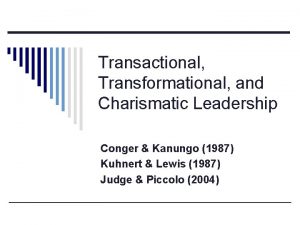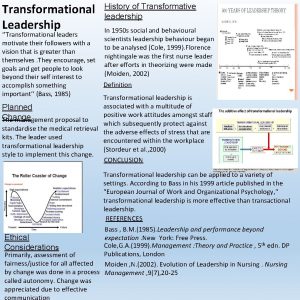Chapter Three Charismatic and Transformational Leadership 2010 Cengage





















- Slides: 21

Chapter Three Charismatic and Transformational Leadership © 2010 Cengage Learning. All Rights Reserved. May not be scanned, copied or duplicated, or posted to a publicly accessible website, in whole or in part. 1

Learning Objectives Describe many of the traits and behaviors of charismatic leaders. ¡ Explain the visionary component of charismatic leadership. ¡ Explain the communication style of charismatic leaders. ¡ Have an action plan for developing your charisma. ¡ © 2010 Cengage Learning. All Rights Reserved. May not be scanned, copied or duplicated, or posted to a publicly accessible website, in whole or in part. 2

Learning Objectives (cont’d) ¡ ¡ ¡ Explain the nature of transformational leadership. Identify several of the impacts of charismatic and transformational leadership on performance and behavior. Describe the concerns about charismatic leadership from the scientific and moral standpoint. © 2010 Cengage Learning. All Rights Reserved. May not be scanned, copied or duplicated, or posted to a publicly accessible website, in whole or in part. 3

Charisma Defined ¡ ¡ ¡ Charisma is a Greek word meaning “divinely inspired gift” In leadership, charisma is a special quality of leaders whose purposes, powers, and extraordinary determination differentiate them from others In general use, charisma is having a charming and colorful personality © 2010 Cengage Learning. All Rights Reserved. May not be scanned, copied or duplicated, or posted to a publicly accessible website, in whole or in part. 4

Charisma: A Relationship Between the Leader and Group Members Key to charismatic leadership is the interaction between leader and group members ¡ Charismatic qualities must be attributed to the leader by group members ¡ Charismatic leaders use impression management to cultivate their relationships with group members ¡ © 2010 Cengage Learning. All Rights Reserved. May not be scanned, copied or duplicated, or posted to a publicly accessible website, in whole or in part. 5

The Effects of Charisma ¡ Group members l l l trust the leader’s beliefs have beliefs similar to those of the leader accept the leader unquestioningly have affection for the leader willingly obey the leader © 2010 Cengage Learning. All Rights Reserved. May not be scanned, copied or duplicated, or posted to a publicly accessible website, in whole or in part. 6

The Effects of Charisma (cont’d) ¡ Group members l l identify with and attempt to emulate the leader have emotional involvement in the mission have heightened goals feel that they will be able to accomplish, or to contribute to the accomplishment of the mission © 2010 Cengage Learning. All Rights Reserved. May not be scanned, copied or duplicated, or posted to a publicly accessible website, in whole or in part. 7

Figure 3 -1 Halpert’s Dimensions of Charisma © 2010 Cengage Learning. All Rights Reserved. May not be scanned, copied or duplicated, or posted to a publicly accessible website, in whole or in part. 8

Types of Charismatic Leaders 1. 2. Socialized charismatics restrain the use of power in the interest of others. Followers have clear values and are independent and honest workers. Personalized charismatics use power to serve their own interests. Followers have an obedient, submissive, and dependent work style. © 2010 Cengage Learning. All Rights Reserved. May not be scanned, copied or duplicated, or posted to a publicly accessible website, in whole or in part. 9

Types of Charismatic Leaders (cont’d) 3. Office-holder charismatics attain their charisma chiefly from the position they hold. 4. Personal charismatics gain esteem from others’ faith in them as people, independent of office or position held. 5. Divine charismatics were once defined by strictly by theological concept of possessing divine grace, but now, qualities of mysticism, narcissism, and magnetism also characterize this type. © 2010 Cengage Learning. All Rights Reserved. May not be scanned, copied or duplicated, or posted to a publicly accessible website, in whole or in part. 10

Characteristics of Charismatic Leaders ¡ ¡ ¡ Visionary Masterful communication skills Ability to inspire trust Able to make group members feel capable Energy and action orientation ¡ ¡ ¡ © 2010 Cengage Learning. All Rights Reserved. May not be scanned, copied or duplicated, or posted to a publicly accessible website, in whole or in part. Emotional expressiveness and warmth Romanticize risk Unconventional strategies Self-promoting personality Dramatic and unique 11

The Vision Component ¡ ¡ Vision is the ability to imagine different and better future conditions and ways to achieve them Charismatic leaders inspire others with their visions, which are often lofty, longterm goals. Visionaries have unique brain activity, suggests recent neuroscience research. A vision differs from a mission. A mission defines an organization’s purpose, whereas a vision draws a picture of what the future will be. © 2010 Cengage Learning. All Rights Reserved. May not be scanned, copied or duplicated, or posted to a publicly accessible website, in whole or in part. 12

The Vision Component, cont’ ¡ A strong and clear vision statement should have the following elements: l l l A reason for being beyond making money Timeless, unchanging core values Ambitious but achievable goals © 2010 Cengage Learning. All Rights Reserved. May not be scanned, copied or duplicated, or posted to a publicly accessible website, in whole or in part. 13

The Communication Component ¡ ¡ Charismatic leaders’ communication style is typically colorful, imaginative, open, and expressive Management by Inspiration l l ¡ Using metaphors and analogies to appeal to the intellect, imagination, and values of group members Gearing language to different audiences Management by Anecdote l Inspiring and instructing team members by storytelling © 2010 Cengage Learning. All Rights Reserved. May not be scanned, copied or duplicated, or posted to a publicly accessible website, in whole or in part. 14

Techniques for Developing Charisma ¡ ¡ ¡ ¡ Create visions for others Be enthusiastic, optimistic, and energetic Be sensibly persistent, (almost) never-say -no Remember peoples’ names Develop synchrony with others, “connect” Develop a personal brand be polished Be candid, yet not insensitive, and direct If appropriate for your work, display an in -your-face attitude © 2010 Cengage Learning. All Rights Reserved. May not be scanned, copied or duplicated, or posted to a publicly accessible website, in whole or in part. 15

Transformational Leadership The transformational leader helps bring about major, positive changes ¡ Transformational leaders move group members beyond their selfinterests for the good of the group, organization, or society ¡ © 2010 Cengage Learning. All Rights Reserved. May not be scanned, copied or duplicated, or posted to a publicly accessible website, in whole or in part. 16

Figure 3 -2 How Transformations Take Place © 2010 Cengage Learning. All Rights Reserved. May not be scanned, copied or duplicated, or posted to a publicly accessible website, in whole or in part. 17

Attributes of a Transformational Leader ¡ ¡ ¡ Charismatic Emotionally intelligent Extroverted Creates and communicates a vision Encourages the personal development of others © 2010 Cengage Learning. All Rights Reserved. May not be scanned, copied or duplicated, or posted to a publicly accessible website, in whole or in part. ¡ ¡ ¡ Provides supportive leadership Practices empowerment Thinks innovatively Leads by example Often employs moral reasoning 18

Concerns About Charismatic Leadership ¡ ¡ ¡ According to the concept of leadership polarity, leaders are often either revered or vastly unpopular, e. g. Martha Stewart Charisma may not be necessary for leadership effectiveness Charisma and its effects on leadership is a matter of perception; one may not necessarily affect the other Charismatic leadership may lead to unethical, illegal or immoral actions Some charismatic and transformational leaders neglect their social responsibility © 2010 Cengage Learning. All Rights Reserved. May not be scanned, copied or duplicated, or posted to a publicly accessible website, in whole or in part. 19

Summary ¡ ¡ ¡ Charisma is a special quality of some leaders that differentiates them from others Charismatic leaders often contribute to group members’ attributions of their charismatic qualities through impression management The effects of charismatic leadership can be organized into three dimensions: referent power, expert power, and job involvement © 2010 Cengage Learning. All Rights Reserved. May not be scanned, copied or duplicated, or posted to a publicly accessible website, in whole or in part. 20

Summary (cont’d) ¡ ¡ There are five types of charismatic leaders: socialized, personalized, officeholder, personal, and divine Charismatic and transformational leaders are able to articulate a vision in such a way as to inspire others Charisma can be developed There may be a dark side to charismatic leadership © 2010 Cengage Learning. All Rights Reserved. May not be scanned, copied or duplicated, or posted to a publicly accessible website, in whole or in part. 21
 Transformational vs transformative leadership
Transformational vs transformative leadership Four components of leadership northouse
Four components of leadership northouse Full range leadership model
Full range leadership model 2010 cengage learning
2010 cengage learning Kouzes and posner transformational leadership
Kouzes and posner transformational leadership Transformational leadership and conflict management
Transformational leadership and conflict management Idealised influence examples
Idealised influence examples How is steve jobs a transformational leader
How is steve jobs a transformational leader Transformational leadership factors the 4 i's
Transformational leadership factors the 4 i's Howard schultz leadership qualities
Howard schultz leadership qualities Transformational leadership
Transformational leadership Transformational leadership synonym
Transformational leadership synonym Lydia dreyer
Lydia dreyer Steve jobs transformational leadership
Steve jobs transformational leadership Transformational leadership questionnaire tlq
Transformational leadership questionnaire tlq Peter g schultz
Peter g schultz Transformational leadership inventory
Transformational leadership inventory Howard schultz transformational leadership
Howard schultz transformational leadership Steve jobs as transformational leader
Steve jobs as transformational leader Transformational leadership
Transformational leadership Transcendent leadership vs transformational
Transcendent leadership vs transformational Steps for transformational leadership
Steps for transformational leadership






































